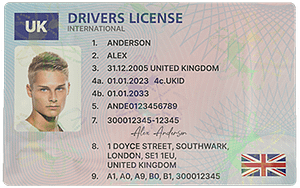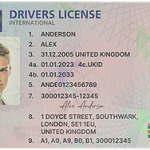In a world where identity – related crimes are on the rise, being vigilant against fake ID card scams is of utmost importance. Fake ID card scams can have far – reaching consequences, from financial losses to damage to one’s reputation. Here are some essential steps to protect yourself:
### Be Wary of Suspicious Requests
One of the first signs of a potential fake ID card scam is an unsolicited request for your ID card information. Whether it comes in the form of an email, a phone call, or a text message, exercise extreme caution. Scammers often pose as legitimate entities such as banks, government agencies, or service providers. For example, an email might claim to be from your bank, asking you to update your account information by providing your ID card details. Legitimate organizations will rarely ask for such sensitive information via these channels. If you receive such a request, contact the organization directly using a verified phone number or website, not the contact information provided in the suspicious message.
### Verify the Source
When dealing with any entity that requests your ID card information, verify its authenticity. If it’s a company or organization, check their official website, look for contact information on well – known and reliable sources such as business directories. For government agencies, use official government websites to confirm the legitimacy of the request. For instance, if you receive a call claiming to be from the tax department asking for your ID card details, do not provide the information immediately. Instead, visit the official tax department website or call their official customer service number to inquire about the request.

### Understand the ID Card Verification Process
Educate yourself about the proper procedures for ID card verification. Legitimate verification processes usually involve in – person checks, secure online portals with proper authentication measures, or official forms. For example, when applying for a loan, the lender will typically verify your ID card in a secure manner, such as through a face – to – face meeting or a secure online system that complies with data protection regulations. If someone asks you to send a photo of your ID card via an unsecured email or messaging app, it’s a red flag. Reputable organizations will use encrypted channels or in – person verification methods for sensitive information.
### Protect Your Physical ID Card
Your physical ID card is a valuable asset. Keep it in a safe place at all times. Avoid carrying it with you unless necessary, especially in high – risk areas. If you do carry it, make sure it’s in a secure wallet or purse. Also, be cautious when showing your ID card in public. For example, when checking into a hotel, make sure the person asking for your ID card is an authorized hotel employee and that the environment is secure. If you lose your ID card, report it immediately to the relevant issuing authority to prevent it from being misused.
### Be Cautious with Online Transactions
Online transactions can also be a breeding ground for fake ID card scams. When making purchases or providing ID – related information online, ensure that the website is secure. Look for the “https” in the website URL and a padlock icon in the address bar. This indicates that the website uses encryption to protect your information. Additionally, be wary of websites that offer deals that seem too good to be true, as they may be phishing sites designed to steal your ID card information and other personal data.
### Regularly Monitor Your Accounts
Regularly monitor your financial and other accounts for any suspicious activity. Check your bank statements, credit card bills, and other account – related notifications. If you notice any unauthorized transactions or changes, report them immediately. Scammers may use fake ID card information to access your accounts and make fraudulent transactions. By staying vigilant and monitoring your accounts, you can detect and prevent potential losses in a timely manner.
### Expand on Common Problems and Solutions
#### 1. Phishing Emails
**Problem**: Phishing emails are a common way scammers try to obtain ID card information. These emails are designed to look like they are from legitimate organizations, often using official – looking logos and language. They may ask you to click on a link to “update” your ID card information or provide other personal details.
**Solution**: First, never click on links in unsolicited emails. Hover over the link to see the actual URL; if it looks suspicious (e.g., has misspellings or is an unfamiliar domain), do not click. Instead, go directly to the official website of the supposed sender by typing the URL into your browser. Also, enable email filtering features that can detect and block known phishing emails.
#### 2. Impersonation Calls
**Problem**: Scammers may call and impersonate representatives from banks, government agencies, or other institutions. They may claim there is an urgent issue with your ID card or account and ask for your ID card details over the phone.
**Solution**: If you receive such a call, ask for the caller’s name, department, and contact number. Then, end the call and contact the organization directly using a verified phone number (found on the official website or on your official statements). Do not provide any ID card information based solely on the call.
#### 3. Social Media Scams
**Problem**: Scammers may create fake social media profiles or send messages through social media platforms asking for ID card information. They may use various pretexts, such as offering a job or a special offer, to trick you into providing the information.
**Solution**: Be very cautious about sharing personal information on social media, especially ID – related details. Do not accept friend requests or messages from unknown or suspicious accounts. If someone asks for your ID card information on social media, consider it a red flag and report the account to the platform.
#### 4. Public Wi – Fi Vulnerabilities
**Problem**: When using public Wi – Fi networks, your ID card information can be at risk. Hackers can set up fake access points or use other techniques to intercept data transmitted over the network.
**Solution**: Avoid accessing sensitive information, such as ID card – related data, when connected to public Wi – Fi. If you must do so, use a virtual private network (VPN) to encrypt your connection. A VPN creates a secure tunnel between your device and the internet, protecting your data from being intercepted.
#### 5. Fake ID Card Vendors
**Problem**: Some individuals may be tempted to buy or use fake ID cards for various reasons, such as under – age drinking or getting around certain restrictions. However, this not only exposes them to legal risks but also makes them vulnerable to scams. Fake ID card vendors may take their money and not deliver the promised ID or may use their personal information for other illegal activities.
**Solution**: Do not engage with any fake ID card vendors. It is illegal to buy, sell, or use fake ID cards. Instead, if you need a legitimate ID card, follow the proper procedures provided by the relevant issuing authorities. This ensures that your identity is protected and that you are operating within the bounds of the law.


